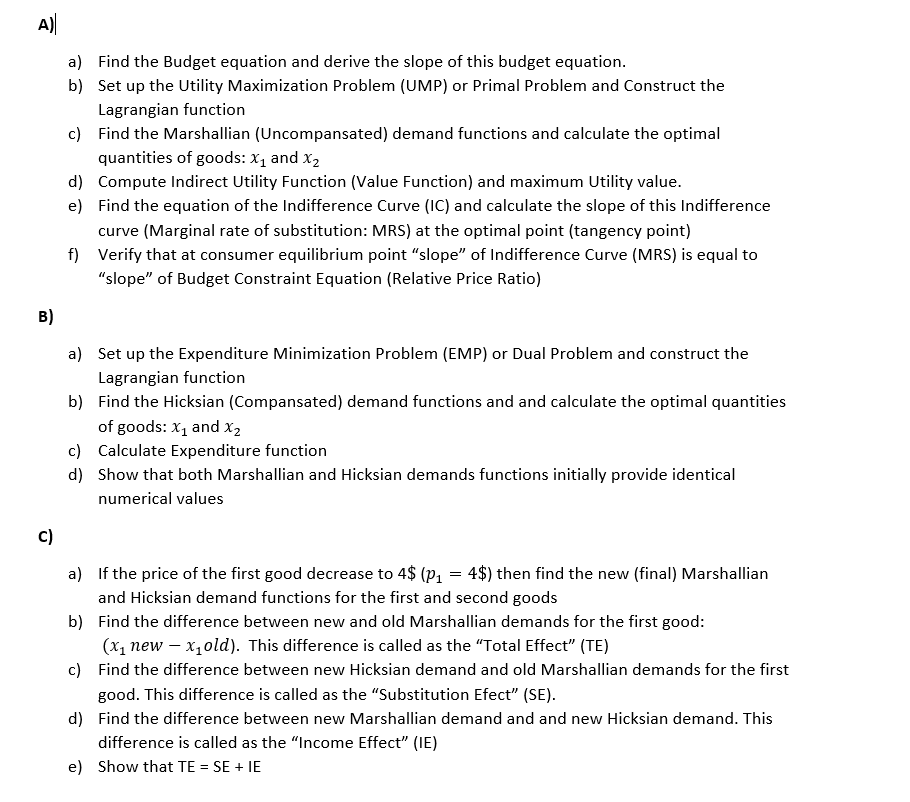0.5, Utility function is given as Cobb Douglas functional form: U = x1.5x2.5 Price the first good: P₁ = 5$ Price the second good: P₂ Income: I = 500$ = 10$
0.5, Utility function is given as Cobb Douglas functional form: U = x1.5x2.5 Price the first good: P₁ = 5$ Price the second good: P₂ Income: I = 500$ = 10$
Micro Economics For Today
10th Edition
ISBN:9781337613064
Author:Tucker, Irvin B.
Publisher:Tucker, Irvin B.
Chapter6: Consumer Choice Theory
Section: Chapter Questions
Problem 1SQ
Related questions
Question

Transcribed Image Text:Utility function is given as Cobb Douglas functional form: U =
Price the first good: P₁ = 5$
Price the second good: P₂ = 10$
Income: I = 500$
0.5 0.5

Transcribed Image Text:A)
a) Find the Budget equation and derive the slope of this budget equation.
b)
Set up the Utility Maximization Problem (UMP) or Primal Problem and Construct the
Lagrangian function
c)
Find the Marshallian (Uncompansated) demand functions and calculate the optimal
quantities of goods: X₁ and X₂
d)
Compute Indirect Utility Function (Value Function) and maximum Utility value.
e)
Find the equation of the Indifference Curve (IC) and calculate the slope of this Indifference
curve (Marginal rate of substitution: MRS) at the optimal point (tangency point)
f)
Verify that at consumer equilibrium point "slope" of Indifference Curve (MRS) is equal to
"slope" of Budget Constraint Equation (Relative Price Ratio)
B)
C)
a)
Set up the Expenditure Minimization Problem (EMP) or Dual Problem and construct the
Lagrangian function
b)
Find the Hicksian (Compansated) demand functions and and calculate the optimal quantities
of goods: X₁ and X₂
Calculate Expenditure function
c)
d)
Show that both Marshallian and Hicksian demands functions initially provide identical
numerical values
a)
If the price of the first good decrease to 4$ (p₁ = 4$) then find the new (final) Marshallian
and Hicksian demand functions for the first and second goods
b)
Find the difference between new and old Marshallian demands for the first good:
(x₁ new x₁ old). This difference is called as the "Total Effect" (TE)
c)
Find the difference between new Hicksian demand and old Marshallian demands for the first
good. This difference is called as the "Substitution Efect" (SE).
d) Find the difference between new Marshallian demand and and new Hicksian demand. This
difference is called as the "Income Effect" (IE)
e) Show that TE = SE + IE
Expert Solution
This question has been solved!
Explore an expertly crafted, step-by-step solution for a thorough understanding of key concepts.
This is a popular solution!
Trending now
This is a popular solution!
Step by step
Solved in 2 steps

Follow-up Questions
Read through expert solutions to related follow-up questions below.
Follow-up Question

Transcribed Image Text:B)
a)
Set up the Expenditure Minimization Problem (EMP) or Dual Problem and construct the
Lagrangian function
b)
Find the Hicksian (Compansated) demand functions and and calculate the optimal quantities
of goods: X₁ and X₂
c) Calculate Expenditure function
d)
Show that both Marshallian and Hicksian demands functions initially provide identical
numerical values
Solution
Knowledge Booster
Learn more about
Need a deep-dive on the concept behind this application? Look no further. Learn more about this topic, economics and related others by exploring similar questions and additional content below.Recommended textbooks for you





